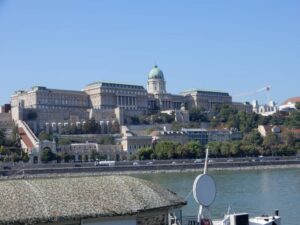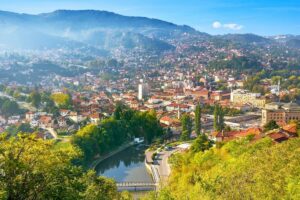Rio de Janeiro - Travel Guide
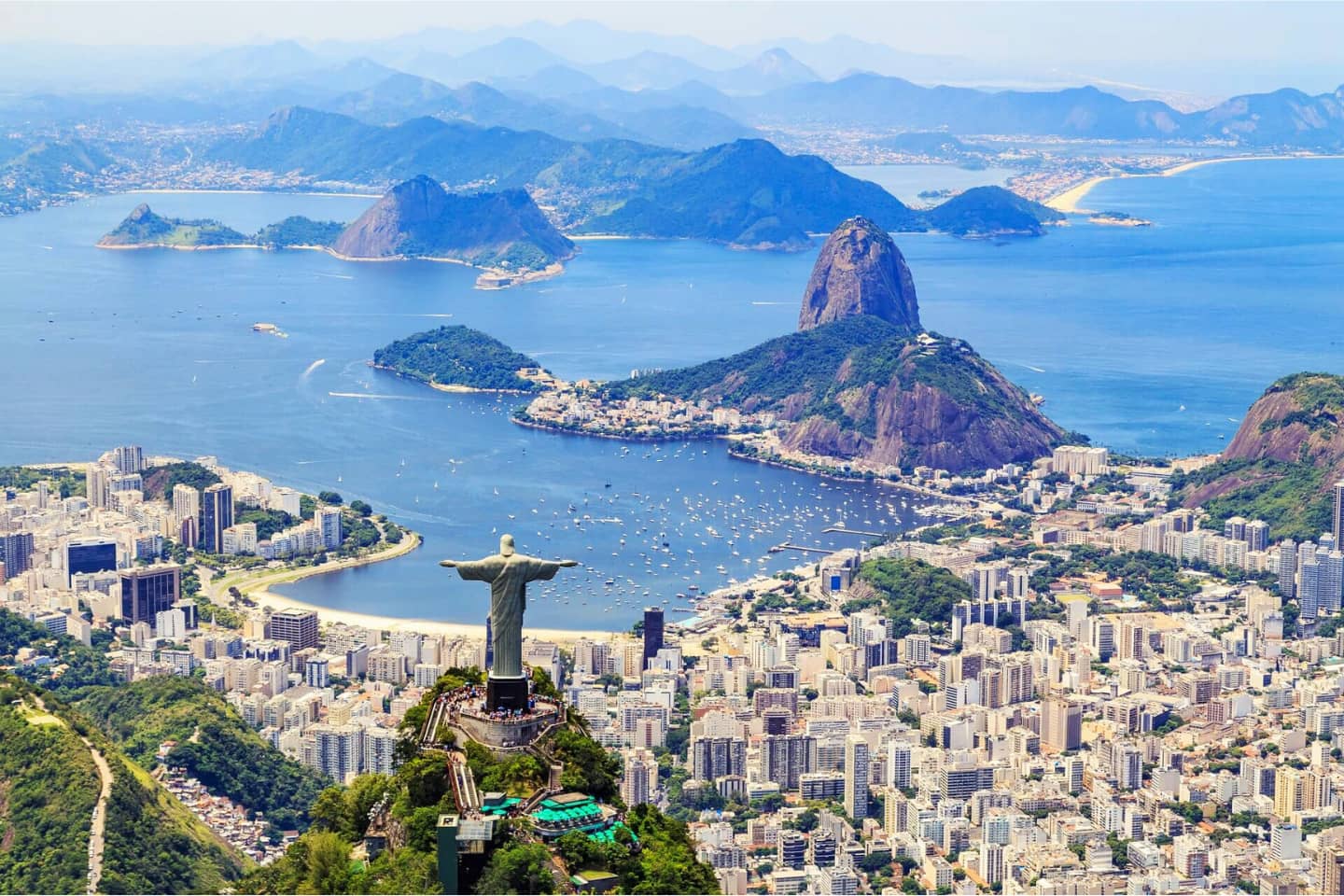
- Jose Carlos Costa
When we talk about the state of Rio de Janeiro, the city of Rio de Janeiro comes to mind.
However, Rio de Janeiro is also the name of the state and offers much more than Copacabana Beach, Corcovado and Christ the Redeemer.
Rio de Janeiro is a state that overflows with beauty, history, culture and joy. From the hustle and bustle of the capital to the historic cities, mountains and paradisiacal beaches, Rio invites you to live unique and unforgettable experiences.
Whether it’s relaxing in a charming inn, exploring trails in the middle of the Atlantic Forest, savoring the gastronomy or visiting centuries-old buildings, these destinations offer experiences for all tastes.
Table of contents
The state of Rio de Janeiro is worth visiting
Absolutely! Rio de Janeiro offers a perfect mix of stunning natural landscapes, such as Sugarloaf Mountain and Christ the Redeemer, with charming historic cities, such as Paraty, and paradisiacal beaches, such as Arraial do Cabo.
In addition, located in the lush Serra Fluminense, Petrópolis and Teresópolis offer unique experiences. Petrópolis, with its imperial charm, invites you to explore the Imperial Museum and the Crystal Palace, while Teresópolis enchants with the majestic view of Dedo de Deus and trails in the Serra dos Órgãos National Park.
Both cities offer a mild climate, stunning landscapes and a rich history, making them perfect destinations for those seeking culture, nature and tranquility.
Another great attraction is Itatiaia, which is nestled in the Serra da Mantiqueira mountain range. The city is famous for being home to the Itatiaia National Park, the country’s first national park, opened in the 1930s. Many of Itatiaia’s attractions are concentrated in this park, such as trails, waterfalls and famous mountains such as the Pico das Agulhas Negras.
The Itatiaia National Park, together with the Serra dos Órgãos National Park, make it a paradise for Brazilian mountaineers.
Culture
The culture of the state of Rio de Janeiro is a vibrant mix of African, indigenous and European influences, which is revealed in the way of life, music, faith and art.
Samba was born in the hills of Rio and became a national symbol. Funk, straight from the communities, expresses reality with striking beats.
Art is everywhere: on the streets, in graffiti, in theaters and museums. Popular festivals, such as Carnival and Saint George’s Day, mix tradition, faith and joy.
The cuisine also reflects this diversity — from feijoada to Globo biscuits on the beaches. The people of Rio de Janeiro have a light, creative and welcoming way, which is contagious to those who visit. Whether in the capital or in the countryside, the culture is alive and in constant movement.
With all this, it is impossible to visit Rio and not be enchanted by this unique energy that combines history, music, flavor and emotion in every corner of the state.
What to do in the main cities of the State of Rio de Janeiro.
- Rio de Janeiro:
- Visit Christ the Redeemer and Sugarloaf Mountain.
- Walk along the beaches of Copacabana and Ipanema.
- Explore the historic center and the Santa Teresa neighborhood.
- Watch a soccer game at Maracanã.
- Paraty:
- Walk along the cobblestone streets of the historic center.
- Explore the islands and beaches of Paraty Bay.
- Visit the cachaça distilleries.
- Arraial do Cabo:
- Diving in the crystal clear waters of Praia do Forno.
- Taking a boat trip around Ilha do Farol.
- Relaxing on the paradisiacal beaches.
- Petrópolis:
- Visit the Imperial Museum.
- Walking through the historic center.
- Enjoying the mountain climate.
Hiking in the mountains
When to go
Rio de Janeiro is amazing all year round, but each season has its own particularities. Depending on what you’re looking for—beach, cultural tourism, less crowds or milder temperatures—there’s an ideal time for you.
Summer (December to March)
What to expect?
This is the hottest season of the year. The heat is intense, the days are long and the sun shines brightly. Perfect for those who want to enjoy the beach, sweat it out dancing at Carnival or enjoy the nightlife.
Highlights of the season:
- Carnival: this is the height of Rio’s energy. Street parties, parades and lots of excitement everywhere. If you like to party, this is the time.
- Crowded beaches: Copacabana, Ipanema and Leblon are bustling. Ideal for those who like movement and partying.
- Summer rain: quick and heavy in the late afternoon, but nothing that will ruin the party.
- High season: prices go up a lot — so it’s worth planning in advance.
Autumn (April to June)
What to expect?
Milder temperatures, less rain and a quieter city. You can still go to the beach, but without the unbearable heat. The climate is super pleasant.
Highlights of the season:
Fewer tourists: you can enjoy the sights at a more leisurely pace.- Clear skies: ideal for taking incredible photos of Sugarloaf Mountain and Christ the Redeemer.
- Lower prices: accommodation and flights are more affordable.
- Cultural events: several theaters, exhibitions and festivals take place at this time.
Winter (July to September)
What to expect?
Winter in Rio is very mild. Is it cold? Sometimes. But generally the weather is dry and the days are beautiful. It is not uncommon to see temperatures of 25°C in the middle of the day. Yes, you can go to the beach even in winter.
Highlights of the season:
Blue skies all day: great for outdoor activities, such as hiking and viewing points.- Less lines: everything is quieter at the main tourist attractions.
- Affordable prices: excellent option for those who want to save money without giving up experiences.
- Pleasant weather: ideal for those who want to enjoy Rio in comfort and peace.
Spring (October and November)
What to expect?
This is the perfect transition between the mild weather and the summer heat. The days start to get warmer, but you can still walk around without sweating too much.
Highlights of the season:
- Flowers everywhere: the city becomes more colorful, especially in the gardens and parks.
- Outdoor events: concerts, fairs and cultural activities are gaining momentum.
- Less crowded beaches: great for those who want to enjoy the sea without the crowds.
- Balanced climate: neither too hot nor too cold. A delight.
Conclusion: what is the best time?
If you want the beach and excitement, go in the summer. If you prefer a more relaxed and economical climate, choose autumn or winter. Spring is that delightful middle ground.
Consequently, Rio is one of those destinations that shines all year round.
The only thing that changes is the pace — and that’s great.
How to get there
- By plane: Rio de Janeiro has two international airports, Galeão and Santos Dumont.
- By car: Rio de Janeiro is crossed by important highways, such as BR-101 and BR-116.
- By bus: several bus companies offer trips to Rio de Janeiro from other cities in Brazil and even other countries.
GET YOUR FREE TRAVEL STARTER KIT
Enter your email and receive planning tips including a step-by-step checklist, how to pack, and more so you can plan your trip like a pro!

How to get around
- In Rio de Janeiro city:
- Metro: a quick and efficient way to get around the city.
- Bus: several bus lines connect the main tourist attractions.
- Taxi and ride-hailing apps: convenient options for getting around the city
- In other cities in the state:
- Bus: the most common way to get around between cities.
- Car: ideal for those seeking more freedom and flexibility.
Costs
Rio de Janeiro offers accommodation, food and tour options for all budgets. You can find everything from luxurious hotels and sophisticated restaurants to hostels and simpler restaurants.
The cost of a trip can vary greatly, depending on your style, time of year and desires.
Just for reference, I will list the 3 styles and their most common costs. Prices are based on a solo trip (1 person).
Economic
Staying in hostels using shared dormitories, making your own food and/or eating at local and cheap restaurants, using local transport, exploring the city on foot and taking free or cheap tours.
- Meals: $6 – $12
- Accommodation: $6 – $15
- Transportation: $4 – $10
- Tours: $10 – $20
Estimated daily cost: $30 – $60.
intermediary
Staying in hostels/budget hotels in private rooms, eating in average restaurants, going to major paid attractions, using some taxis and Uber.
- Meals: $15 – $20
- Accommodation: $20 – $50
- Transportation: $10 – $20
- Tours: $30 – $50
Estimated daily cost: $65 – $140.
Luxurious
Staying in the best hotels, going to all the attractions, hiring more sophisticated packages such as using a helicopter, etc.
- Meals: $30 – $60
- Accommodation: $60 – $120
- Transportation: $40 – $60
- Tours: $80 – $120
Estimated daily cost: $210-$320 and up.
Table of Contents
Security
The State of Rio de Janeiro has places ranging from the safest and most peaceful to the most hectic and unsafe.
Certainly one of the places that requires the most care is the Capital and tourist attractions such as Copacabana, Christ the Redeemer, etc.
Also during major events such as Carnival, major concerts such as New Year’s Eve and other international shows.
Keep in mind the 15 foolproof tips for traveling safely in any country.
As well as the reinforcement of the actions that you should take when traveling to Brazil in Brazil with Safety: Travel More and Better
Security Recommendations in the State of Rio de Janeiro:
- Money and Valuables:
- Carry little cash and avoid showing off jewelry or other valuables.
- Prefer to use credit and debit cards, which are accepted in almost all places.
- Using the Beaches:
- Do not leave your belongings abandoned on the beach, even for a short period.
- Keep your belongings in a safe place, such as a backpack or discreet bag.
- Be aware of currents in the sea, especially on more remote beaches.
- Do not venture into unfamiliar waters.
- Getting around:
- Use taxis or public transportation to get around, especially at night.
- Avoid walking alone on deserted or poorly lit streets.
- Be aware of your surroundings:
- Be aware of your surroundings, especially in crowds.
- Pay attention to the people around you and avoid isolating yourself in deserted or dark places.
- General Safety:
- Avoid talking or using your cell phone on public transportation.
- Do not use GPS, as it can lead to dangerous places.
- Plan the places you want to visit and ask the police or shops for directions.
- If you plan to stand on a street corner, be extra vigilant and, if possible, do so on a busy street.
- Behavior:
- At night, dress like the locals.
- Use your cameras safely and pay close attention.
- Be discreet and avoid attracting attention.
- Communities:
- Avoid tourism in communities, especially on foot (on your own).
- If you are going to take a tour, make sure the company is trustworthy.
- Other Tips:
- Whenever possible, try to travel in groups.
- For women, if there is a man in your group, it also helps.
- If there are only women, be extra careful.
- Don’t forget to stay hydrated and protect yourself from the sun.
- If you need help, look for a police officer (dial 190), Women’s Assistance (dial 180), SAMU (Mobile Emergency Care Service) dial 192.
Main cities in the State of Rio de Janeiro
Rio de Janeiro city
Rio de Janeiro is certainly the best-known tourist destination in Brazil.
However, most come with the image of the beaches of Ipanema and Copacabana, Christ the Redeemer, samba and lots of sun.
However, Rio de Janeiro is much more than that, being a fascinating mix of natural beauty, vibrant culture and a relaxed lifestyle.
The city is known as the “Marvelous City” due to its concentration of stunning landscapes such as Christ the Redeemer, Pedra da Gávea, Sugar Loaf, offering unparalleled panoramic views of the city and of course its beaches.

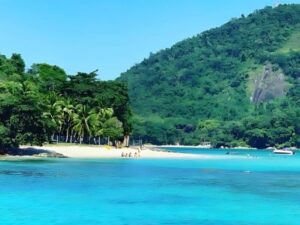
Angra dos Reis
Angra dos Reis is one of the most famous destinations in the state, located 150 km from the capital.
The destination offers more than 300 islands, in a sea of green and crystal clear waters and a spectacular coastline, perfect for diving and water sports.
In addition to the beaches, Angra has an excellent tourist infrastructure, with resorts, charming inns and a very lively nightlife.
Arraial do Cabo
Arraial do Cabo, just 165 km from the city of Rio de Janeiro.
The city is a true natural paradise, which boasts the suggestive nickname of “Brazilian Caribbean” thanks to its white sand beaches and incredibly clear waters.
Arraial do Cabo brings together some of the most beautiful features of the Brazilian coast, such as white sand dunes, restinga vegetation.
In addition to cliffs that function as viewpoints to appreciate all this.
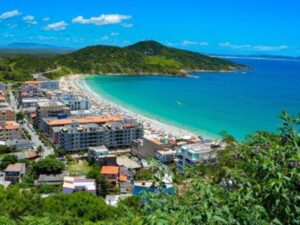
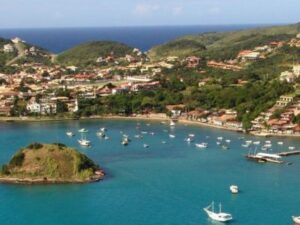
Búzios
Búzios, located in the Lakes Region, about 170 km from Rio de Janeiro, is one of the most famous and sophisticated destinations in Brazil.
The city gained notoriety in the 1960s with the visit of French actress Brigitte Bardot.
With her visit, she helped transform the fishing village into an international tourist spot, increasing popular interest in the region’s beautiful beaches with clear waters.
Cabo Frio
The main city of the Lakes Region is 150 km from the capital.
The city is famous for its white sand beaches and crystal clear waters.
In addition to the crystal clear sea and white sand dunes, most of the city’s beaches offer comfortable kiosks to serve the public.
Attracting thousands of tourists every year, especially families on vacation.

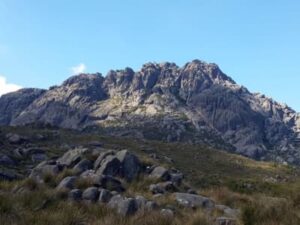
Itatiaia
Located in the Serra da Mantiqueira, the city is famous for being home to the Itatiaia National Park, the country’s first national park, opened in the 1930s. Many of Itatiaia’s attractions are concentrated in this park, such as trails, waterfalls and peaks.
In the lower part, visitors can cool off in places such as the Cascata do Maromba and Lago Azul, as well as having the chance to try the delicious local cuisine.
Especially in winter, when the weather is perfect for cozying up with a good glass of wine in front of the fireplace!
In the upper part, visitors who enjoy mountaineering will have access to the most iconic mountains in the region, such as the Pico das Agulhas Negras, the Shelves, and a multitude of mountain trails.
Paraty
Paraty is famous, often called “Golden Gold with a beach”, just 250 km from the capital.
The historic city seems to have stopped in time, with its cobblestone streets and preserved colonial mansions that make up the charming Historic Center, listed as a National Heritage Site.
But it’s not just the culture, you can enjoy everything that Paraty Bay has to offer, such as islands and beaches with crystal clear waters, perfect for diving and boat trips.
As well as the local cuisine, with a strong Caiçara influence.
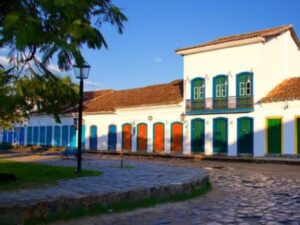
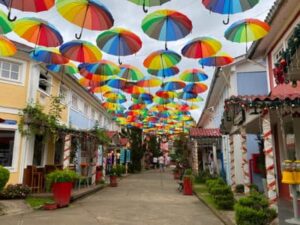
Penedo
Penedo, 170 km from the capital, is a city that became known as “Little Finland” due to the strong influence of Finnish culture in the region, noticeable in every corner.
The center is a charming village with typical architecture and many interesting tourist attractions, such as the famous Santa Claus House,
The city is also perfect for those who enjoy contact with nature, with several waterfalls to visit, such as Poço das Esmeraldas, Cachoeira de Deus and Cachoeira das Três Bacias.
Petrópolis
Located just 70 km from the capital of Rio de Janeiro, Petrópolis is one of the best-known cities in the interior of Rio de Janeiro, especially recommended for travelers who enjoy history and natural beauty.
Known as the Imperial City, Petrópolis was the refuge of Dom Pedro II and its architecture reflects this heritage, with several preserved 19th century buildings and attractions such as the Imperial Museum, which displays more than 300 thousand pieces from the colonial period.
One of the most famous attractions is the Petropolis Teresópolis crossing, known as Petro-Tere.
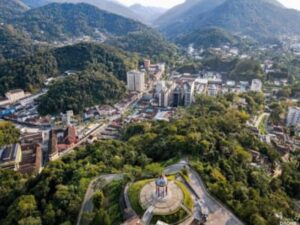
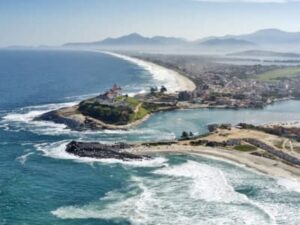
Saquarema
Outro destino da Região dos Lagos que merece a sua visita é Saquarema, a 100 km da Cidade Maravilhosa. A cidade ostenta o título de “Capital Nacional do Surfe”, o que dá uma pista do que você vai encontrar por lá.
A Praia de Itaúna é o principal ponto de encontro entre os surfistas, sendo, inclusive, sede de campeonatos de surfe de grande relevância, mas existem outras praias para quem não deseja se arriscar nas ondas, como a Praia de Jaconé e a Praia de Vilatur, e atrações como o mirante da Pedra do Elefante, o ponto mais alto da cidade.
Embora a cidade seja um destino agradável em qualquer data, o verão mostra Saquarema em seu auge, com condições perfeitas para curtir as praias.
Teresópolis
Teresópolis é uma parada obrigatória para quem procura cidades do interior do RJ para curtir o clima aconchegante da serra, a menos de 100 km do Rio de Janeiro.
Conhecida por seu clima ameno e frio, sobretudo entre junho e agosto, a cidade tem muitas construções históricas e é casa do Centro de Treinamento da Seleção Brasileira de Futebol, que atrai visitantes o ano inteiro.
Aproveite a visita para conhecer a Serra dos Órgãos, um dos cartões-postais do estado, com mais de 200 km de trilhas, e para fazer compras na Feirinha do Alto, uma das maiores feiras ao ar livre do Rio de Janeiro.
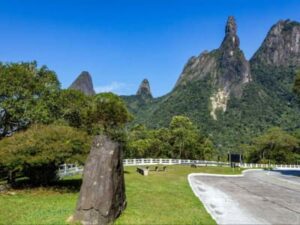
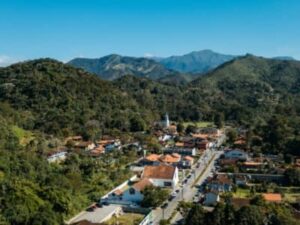
Visconde de Mauá
The last destination on our list is Visconde de Mauá, a charming district of Resende, approximately 200 km from the capital.
The region is ideal for those who enjoy natural beauty and a mild climate, with many trails, opportunities for horseback riding and visits to waterfalls to fill your travel itinerary. The more adventurous may even enjoy Serrinha do Alambari, recommended for rappelling, rock climbing and waterfall climbing.
With a reputation as a romantic destination and many leisure options for the whole family, Visconde de Mauá is even more charming in the spring and summer, when the heat seems to invite you to take a refreshing dip in the region’s rivers!
Let's travel?
Still have questions or need inspiration?
Check out the Blog section, with lots of unmissable tips and articles that will prepare you to discover incredible destinations.
Your next trip starts here
Ready? Then let's hit the road...
Book your flight.
Finding cheap flights can be difficult and stressful, but with the tips from the Blog and using Skyscanner or Google flights, the task can even be enjoyable.
Today, these are the most complete tools on the market
Book your accommodation.
With that in mind, it’s time to choose your accommodation.
The best tool is Booking.com.
For those who are going to use hostels, the best tool is Hostelworld.
I have used both very often and always find the best prices.
Get your insurance
Insurance is something we never want to use, but it is traumatic if we need it and don’t have it.
It will cover the costs of any eventuality of illness, injury, theft and/or cancellations of tickets, hotels, etc.
I have used WorldNomads or Assistcard, which always have the insurance with the coverage that travelers need, in addition to having coverage worldwide.
Related Posts


